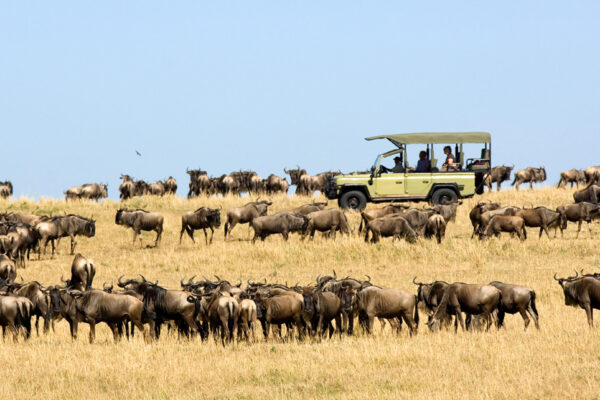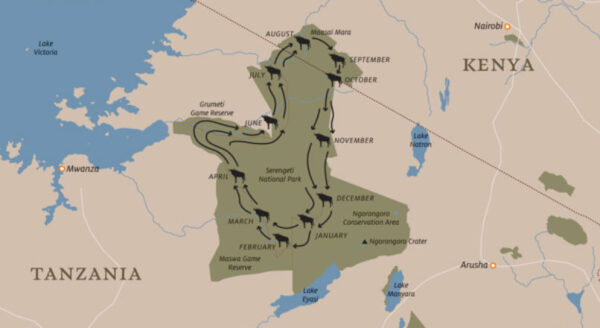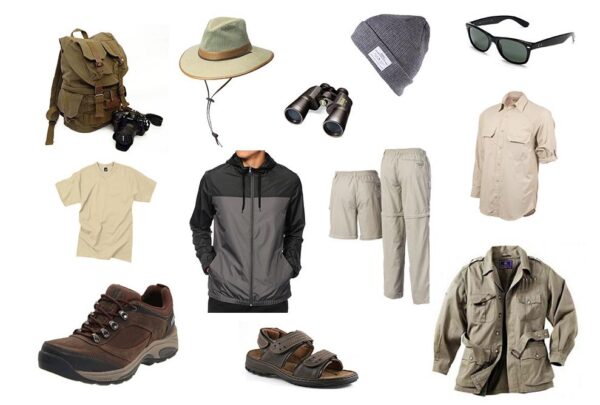Contents
This is the complete guide for the Serengeti and Masai Mara great migration.
This natural wonder attracts wildlife enthusiasts, photographers, and adventure lovers from all over the world.
The migration of over a million wildebeests, along with zebras and gazelles, is a spectacle that showcases the wonders of nature, ecology, and natural history.
In this guide, we will explore the different aspects of the wildebeest migration, from understanding why it happens and how to plan for the wildebeest migration safari
Join us on this journey of discovery and learn why the wildebeest migration is a must-see event for anyone interested in visiting Africa for a wildlife safari.
Great Wildebeest Migration

The wildebeest migration is a remarkable natural event that captures the imagination of wildlife enthusiasts and adventure seekers across the world.
This natural event involves the movement of millions of animals between Tanzania and Kenya.
This involves the well-known destinations, which are the Serengeti and the Masai Mara.
Wildebeest Migration offers a unique opportunity to witness the wonders of the animal kingdom and appreciate the beauty of African wildlife.
What Triggers the Wildebeest Migration?
This migration is triggered by the seasonal movement of rainfall patterns, which drives the wildebeest herds to move in search of fresh grazing pastures.
How do wildebeest migrate?
The wildebeest migration is a mass movement of animals that occurs annually.
The wildebeest moves from one place to another in search of better grazing and water resources.
During the migration, the wildebeest covered a distance of more than 1,800 miles, moving from Tanzania to Kenya and back again.
Migration is not only a sight to behold but also plays a significant role in wildlife conservation and ecology.
What are the Benefits of Wildebeest Migration?
The great migration is not only a breathtaking sight to behold but also has several benefits.
One of the benefits of the wildebeest migration is that it supports the ecological balance of the savanna.
The wildebeests graze on the savanna grasslands, which prevents overgrowth and maintains the natural habitat for other animals.
Additionally, the migration attracts predators like lions, leopards, and hyenas, which help control the population of prey animals.
Wildebeest migration also promotes wildlife conservation by creating a source of income for local communities through safaris and photography tours.
Lastly, it offers an unforgettable adventure travel experience for those interested in natural history and geography.
When and Where to Witness the Migration
Are you a wildlife enthusiast looking for an unforgettable experience in the African savanna?
Witnessing the wildebeest migration is a must-see event.
But when and where is the best time to witness the wildebeest migration?
When is the Best Time to See the Wildebeest Migration?
The best time to see the wildebeest migration is between July and October in the Serengeti and the Masai Mara.
Wildebeest migration calendar in Serengeti

In December, January, February & March
The Serengeti and Ngorongoro are the most impressive wildlife sanctuaries in the world.
From December to March, the plains of Serengeti and Ngorongoro become home to wildebeest.
The great herds graze on rain-ripened grass. This is the best time to visit the Serengeti.
From late January to mid-March, over 80% of wildebeests give birth.
The concentration remains on the Ndutu and Salei plains (south of Serengeti)
This is the best time to observe the predators like lions and cheetahs.
For a better stay, you should focus on staying mobile camp in the Ndutu or Naabi area or at Ndutu Safari Lodge.
In April & May
During April and May, the depleted plains are unable to sustain the endless herds.
The migration swept west and north. Moves from the short grass plains of the south Serengeti
To the long grass plains and woodlands of the Serengeti’s Western Corridor. Almost to Lake Victoria.
The long rain starts during this month and mark the beginning of the low season for game drives. Most trails become impassable.
Which Countries Do the Wildebeest Migrate to?
The migration takes place between Tanzania and Kenya, and the wildebeests cross the Mara River during this period, which is a sight to behold.
Which Parks Offer the Best Wildebeest Migration Experience?
The best parks to see the wildebeest migration in Africa are the Masai Mara Game Reserve in Kenya and Serengeti National Park in Tanzania.
These two parks share the same ecosystem, and the best place to witness the river crossing is at Mara at Kogatende.
Planning for the Wildebeest Migration
Planning a journey to witness the great wildebeest migration on the African savanna is a dream come true for many wildlife enthusiasts.
To ensure a successful and comfortable trip, proper planning is essential.
We will discuss what to pack, how to get to the migration, and the accommodation options available.
Join us in exploring the ecology and natural history of this incredible event, and discover how photography and adventure travel can enhance your experience.
Let’s delve into the world of wildlife conservation and geography as we prepare for the wildebeest migration.
What to Pack for the Wildebeest Migration?

When preparing for a safari to witness the wildebeest migration in the African savanna, it’s important to pack appropriately.
Bring clothes that are comfortable, lightweight, and offer protection from the sun and bugs.
Neutral colors are recommended for photography and to blend in with the environment.
In addition to clothing, bring binoculars, a camera with a zoom lens, and extra memory cards and batteries.
It’s also important to pack any necessary medications and first aid supplies.
Refer to our best article on How to pack for an African Safari
How to get to the Wildebeest Migration?
Serengeti National Park offers easy access. The most convenient option is taking a flight from Arusha to one of the park’s seven airstrips.
It is also possible to book an overland safari in a 4×4WD safari vehicle from Arusha to Serengeti.
You can opt to visit Tarangire or Ngorongoro Crater along the way.
This goes the same for the Masai Mara in Kenya; you can take a flight from Nairobi or book an overland safari to and from Nairobi.
It’s also possible to drive to and from Serengeti via the Isbania or Sirari border between Tanzania and Kenya.
These two parks are accessible throughout the year.
Where to stay during the Wildebeest Migration?
When it comes to witnessing the wildebeest migration in the African savanna, travelers have a variety of accommodation options to choose from.
From luxury lodges to basic camping sites, there is something for everyone’s taste and budget.
Safari camps are a popular option for those seeking an authentic experience in the heart of the wilderness.
They offer comfortable tents with all necessary amenities, as well as game drives and guided walks with experienced rangers.
For those who prefer a more luxurious stay, there are high-end lodges that provide spacious rooms, gourmet meals, and spa treatments.
Read more about Luxury Accomodation in Serengeti
Experiencing the Wildebeest Migration
On your unforgettable trip, you’ll have the opportunity to witness thousands of animals traversing the African savanna in search of greener pastures.
From photography to adventure travel, this experience offers a variety of activities to enjoy.
What Activities Are Available During the Wildebeest Migration?
During the wildebeest migration, there are a variety of activities available for tourists to enjoy.
Safari tours are a popular choice, offering the opportunity to witness the natural spectacle from a safe and comfortable distance.
Many safari tours also provide expert guides who can offer detailed insights into the ecology and natural history of the African savanna.
For those interested in photography, the wildebeest migration offers a unique opportunity to capture stunning images of the animals in motion.
With the right equipment and techniques, photographers can capture the beauty and drama of the migration in stunning detail.
For those seeking adventure travel, there is a range of activities available, including hot air balloon rides, walking safaris, and camping trips.
These activities offer a more immersive experience of the African trips and allow visitors to get up close and personal with the wildlife.
What Precautions Should You Take During the Wildebeest Migration?
During the wildebeest migration, it is crucial to take certain precautions to ensure your safety and that of the animals.
Firstly, it is important to follow the rules and regulations set by the wildlife conservation authorities to maintain the ecological balance of the African savanna.
Secondly, keep a safe distance from the animals and avoid disturbing their natural habitat.
Additionally, photography enthusiasts should respect the animals’ space and not use flash photography, as it may startle them.
Photography Equipment for the Wildebeest Migration
When planning a photography safari to witness the wildebeest migration, it is important to bring the right equipment.
A telephoto lens is a must-have for capturing the animals’ movements from a distance.
A wide-angle lens is also useful for capturing the expansive African savanna landscape.
A tripod or monopod is recommended to stabilize your camera and prevent blurry shots.
Best Photography Tips for the Wildebeest Migration
To capture the best photographs of the wildebeest migration, it is essential to have the right equipment.
A telephoto lens with a focal length of at least 300mm is recommended to capture the animals in their natural habitat.
Additionally, it is crucial to have a fast shutter speed and a high ISO to freeze the motion and capture the details of the animals.
When photographing the wildebeest migration, it is also important to consider the lighting conditions.
Early morning and late afternoon are the best times to capture the animals as the light is softer and creates a warm golden glow.
It is also advisable to use a polarizing filter to reduce glare and enhance the colors of the landscape.
What Makes the Wildebeest Migration an Unforgettable Experience?
The wildebeest migration is an unforgettable experience due to its sheer magnitude and natural spectacle.
Witnessing hundreds of thousands of wildebeest and other herbivores crossing rivers, navigating vast plains, and braving predators is a captivating display of survival instincts.
The constant movement, dramatic river crossings, and the cycle of life and death create a mesmerizing spectacle that stays etched in the memory of all who witness it.
The wildebeest migration is a testament to the power and beauty of nature, making it an experience like no other.
Conclusion
In conclusion, the Great Migration in Serengeti is a world treasure that will never be taken for granted.
With its a spectacular sight of millions of wildebeests, zebras, and gazelles moving in unison across the African savanna.
The migration is an awe-inspiring natural wonder that is a must-see for any wildlife enthusiast.
Are you ready for an adventure of a lifetime? Check out these tours for you!
5 Days Ndutu Migration Serengeti
8 Days Wildebeest Migration Serengeti (River- Crossing)
Frequently Asked Questions ( FAQ)

When is the best time to see the Great Wildebeest Migration?
The best time depends on what you want to see: Calving season (Jan-Mar) in Southern Serengeti, River Crossings (Jul-Oct) at the Mara River, and the herds in the Masai Mara (Aug-Oct). Each period offers unique experiences
Where does the wildebeest migration occur?
The migration follows a circular route through Serengeti National Park in Tanzania and Masai Mara National Reserve in Kenya, covering approximately 800km annually.
How many animals participate in the migration?
Approximately 1.5 million wildebeest, 400,000 zebra, 200,000 gazelle, and numerous predators follow the migration, making it the largest terrestrial mammal migration on Earth.
What are the river crossing dates?
River crossings typically occur from July to October at the Mara and Grumeti Rivers. Exact timing varies yearly based on rainfall patterns, but peak crossings usually happen in August and September
Is the migration predictable?
While the general pattern is predictable, exact timing varies annually based on rainfall. The herds follow the rains and fresh grass growth, so migration patterns can shift by weeks from year to year
What safari packages are available for migration viewing?
We offer various packages, including 6-day migration-focused safaris, 8-day comprehensive migration circuits, luxury mobile camps that follow the herds, and combined migration & beach holiday packages.
Are you ready to start planning?
You can proceed with booking by filling out the form below. Let’s make your adventure unforgettable!



